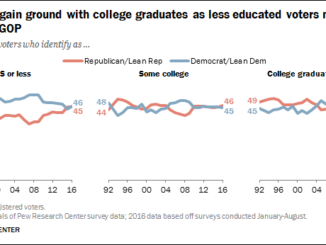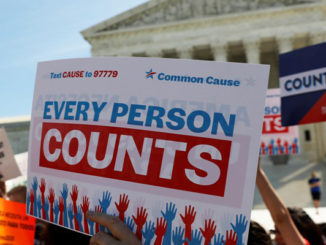by Alex Gonzalez
The Pew Research Center recently published a book title The Next America in which it has an “age pyramid” showing how Americans are “graying.”
 “Our population is becoming majority non-white at the same time a record share is going gray. Each of these shifts would by itself be the defining demographic story of its era. The fact that both are unfolding simultaneously has generated big generation gaps that will put stress on our politics, families, pocketbooks, entitlement programs and social cohesion.
“Our population is becoming majority non-white at the same time a record share is going gray. Each of these shifts would by itself be the defining demographic story of its era. The fact that both are unfolding simultaneously has generated big generation gaps that will put stress on our politics, families, pocketbooks, entitlement programs and social cohesion.
Let’s start with what demographers call an “age pyramid.” Each bar represents a five year age cohort; with those ages 0-4 on the bottom and those ages 85 and older on the top. In every society since the start of history, whenever you broke down any population this way, you’d always get a pyramid.
But from 1960 to 2060, our pyramid will turn into a rectangle. We’ll have almost as many Americans over age 85 as under age 5. This is the result of longer life spans and lower birthrates. It’s uncharted territory, not just for us, but for all of humanity. And while it’s certainly good news over the long haul for the sustainability of the earth’s resources, it will create political and economic stress in the shorter term, as smaller cohorts of working age adults will be hard-pressed to finance the retirements of larger cohorts of older ones.”
When this “age pyramid” becomes a rectangle the country will have the same number of Americans under 35 and over 70 years of age. And this will put a real strain on the federal budget that funds services for this “graying” group of Americans.
Currently, the ratio of beneficiaries to workers is 3 to 1: it takes 3 workers to pay benefits for 1 Social Security beneficiary. But by 2020, the ratio will be only 2 to 1. When the pyramid turns in a rectangle, the ration will be 1 to 1, and therefore, the government will be unable to meet its obligations for entitlements like Medicare, Social Security, Medicaid–all federal programs aimed at helping seniors over 65 of ages irrespective of income . And the only way the government can fund these program will by raising taxes, or cut entitlement by 2/3, to compensate for 3 to 1 ratio of workers.
The principal driver of future federal deficits is the rapidly mounting cost of Medicare. How Are Social Security and Medicare Financed? The major source of financing is payroll taxes on earnings paid by employees and their employers.
Moreover, our current broken entitlements system and is unsustainable and unfair to the young because Entitlements is “the “transferred of wealth” for young Americans to wealthy seniors. According to Samuel Roberson, a young generation of America is being “squeezed” out of their “wealth.”
The young (and I draw the line at 40 and under) face two threats to their living standards. The first is the adverse effect of the Great Recession on jobs and wages. Even if this fades with time, there’s the second threat: the costs of an aging America. It’s not just Social Security, Medicare and Medicaid — huge transfers from the young to the old — but also deferred maintenance on roads, bridges, water systems and power grids. Newsweek calls the young “generation screwed;” I prefer the milder “generation squeezed.”
And this is a similar argument made by Paul Ryan, who is the main GOP policy guy, who argues that our current broken system and how it is unsustainable and unfair to the young because Entitlements is “the “transferred of wealth” for young Americans to wealthy seniors; and both parties are refusing to act.
 In effect, Social Security and Medicare have been transferring money from low earning young people (who don’t pay income tax but are hit by the payroll tax) to increasingly affluent old people; which is the main reason why AARP supports Obamacare while opposing any changes to the current entitlements programs.
In effect, Social Security and Medicare have been transferring money from low earning young people (who don’t pay income tax but are hit by the payroll tax) to increasingly affluent old people; which is the main reason why AARP supports Obamacare while opposing any changes to the current entitlements programs.
Medicare spending—the largest health care purchaser and largest driver of federal entitlement costs and the federal debt—is expected to jump from $522.8 billion in 2010 to $932 billion in 2020. Today, Medicare spending equals 3.6 percent of the national economy as measured by gross domestic product (GDP). By 2030, it will account for between 5.2 percent and 5.9 percent of GDP. The program’s long-term unfunded liabilities—the total cost of the benefits promised but not paid for—amount to a breathtaking $36.8 trillion–-90% of Medicare enrollees are seniors over 65.
So when the “age pyramid” becomes a rectangle by 2050, both parties in Congress will have no other option than raise taxes on businesses and individuals to support 1/3 of the population who will be over 65 and when the county will have the same number of seniors over 85 and Americans under 5.
Alex Gonzalez is a political Analyst and Political Director for Latinos Ready To Vote,
comments to [email protected]




